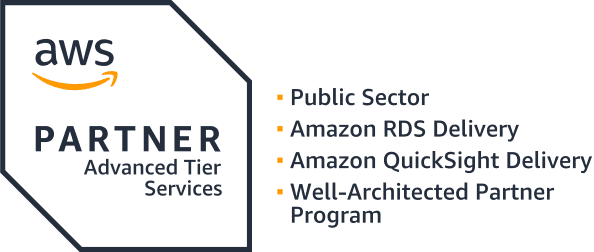What exactly are ETL Tools?
ETL tools allow the gathering of data from various sources, cleansing of data to assure quality and consistency, and aggregation of this data into data warehouses. If utilized correctly, ETL technologies can simplify data management and improve data quality. This is because they provide a consistent approach to processing, sharing, and storing data. Data-driven organizations and platforms are aided by ETL developer technologies. The main benefit of customer relationship management (CRM) platforms, for instance, is that they allow all company operations to be carried out through a single interface. With this, teams can simply share CRM data, which improves visibility into company performance and progress toward objectives.
As an advanced AWS partner, we bring unparalleled expertise to architect, deploy, and optimize cloud solutions tailored to your unique needs.
Elements of ETL Tools
There are four main types of ETL tools that can be classified according to the infrastructure they use and the company or organization that backs them. Below, we define these categories: enterprise-grade, cloud-based, open-source, and custom ETL solutions.
ETL Tools for Enterprise Software
Business entities create and maintain enterprise software ETL tools. Since these businesses were pioneers in promoting ETL tools, their solutions are often the most advanced and reliable options available. This involves providing user groups and documentation in abundance, as well as graphical user interfaces (GUIs) for ETL pipeline architecture, support for the majority of relational and non-relational databases, and more. Due to its complexity, business software ETL technologies often come with a higher price tag, and necessitate more integration services, and training for employees, although offering more capabilities.
Informatica ETL effortlessly integrates and extracts data from many sources. It offers a wide range of data integration tools, including data warehousing, which efficiently stores data from many sources. Data dominates the three key ETL phases of Extract, Transform, and Load (ETL). Informatica PowerCenter is the main data integration product. It is a powerful ETL solution that integrates data for enterprises, industries, governments, and more. Its adaptability extends across telecom, finance, healthcare, and other industry areas, bringing considerable benefits and value to enterprises in these disciplines. Every organization needs good database software to manage massive amounts of data. Informatica ETL meets every business’s need. With this approach, any business may grow.
Open-Source ETL Software
It is hardly surprising that open-source ETL solutions have made it into the marketplace, given the growth of the open-source movement. There are a plethora of free ETL tools available today that provide graphical user interfaces (GUIs) for creating data-sharing procedures and tracking data flow. The ability to examine the tool’s architecture and expand capabilities is a clear benefit of open-source solutions, which businesses can access through the source code. Since open-source ETL solutions are typically not backed by commercial businesses, their maintenance, documentation, usability, and usefulness can vary like-
Pentaho Data Integration
A complete ETL tool, Pentaho Data Integration transforms and processes data. Hadoop, cloud, and other data sources are supported. The advanced features of Pentaho Data Integration include data quality and metadata management.
Apache Spark
The Apache Spark framework improves ETL. Through automation, data pipelines let organizations make faster data-driven decisions. They are crucial to a good ETL process because they aggregate data from numerous sources accurately. Spark naturally supported different data sources and programming languages. Spark ETL cleans relational and JSON data. Spark data pipelines were intended to handle massive data sets.
Cloud-Based ETL Technologies
In response to the meteoric rise in popularity of cloud computing and integration platform as a service, several cloud service providers (CSPs) now provide ETL tools that are proprietary to their platform. Efficiency is a key benefit of ETL solutions that are hosted in the cloud. Cloud computing allows computing resources to scale up or down in response to fluctuations in data processing demand thanks to its high availability, low latency, and elasticity. The pipeline can be even more streamlined if the firm uses the same CSP for data storage as well. This is because all operations can take place within the shared infrastructure. One limitation of ETL tools hosted in the cloud is that they are environment-specific. It is necessary to transfer data from other clouds or on-premise data centers to the provider’s cloud storage before they may be used.
AWS Glue streamlines the creation of the Cloud-Based ETL process- Consolidates all of your data integration requirements into a single service, and eliminates the need for infrastructure management by utilizing automatic provisioning and workforce management.
Building Personal ETL Instruments
Businesses that have the means to do so may use generic programming languages to create their own proprietary ETL tools. The major benefit of this method is that it allows the company to tailor the solution to their own objectives and procedures. Python, SQL, and Java are three of the most common languages used to develop ETL solutions. Internal resources needed to develop, test, maintain, and upgrade a bespoke ETL tool constitute the biggest disadvantage of this strategy. Another thing to think about is the documentation and training needed to bring on new developers and users, all of whom will be unfamiliar with the platform. Next, we’ll go over how to assess ETL developer tools to find the best one for your company’s data processes and use cases, now that you know what they are and what kinds of tools are out there.

The Art of ETL Tool Evaluation
Data collected and valued by a company will mirror its distinctive company structure and culture. Be that as it may, the following are some universally applicable metrics that you can use to evaluate ETL technologies.
- The use case is an essential factor to take into consideration while selecting ETL tools. It is possible that you do not require a solution that is as robust as those required by large businesses that have complicated datasets if your organization is relatively small or if your data analysis needs are very low.
- During the evaluation of ETL software, the budget is another significant issue to take into consideration. The use of open-source technologies is normally free of charge; nevertheless, such solutions could not provide as many capabilities or support as enterprise-grade tools. If the product includes a significant amount of code, another factor to take into account is the resources that are necessary to recruit and keep developers.
- The most effective ETL systems are able to be adapted to address the specific data requirements of a variety of teams and business procedures. Data quality may be enforced and the amount of effort necessary to evaluate datasets can be reduced with the help of ETL tools through the use of automated features such as de-duplication. Additionally, data connectors make it easier to share information between different platforms.
- Every piece of data, whether onsite or in the cloud, should be accessible by ETL tools. In an ETL tool, ETL connectors connect data sources. Organisations may have unstructured or complex data structures stored in many formats. In an ideal scenario, the solution will be able to retrieve information from any and all sources and store it in formats that are defined.
- Developers and end users’ data and code fluency and technical literacy are important. Manually coding a tool should allow the development team to use its languages. However, an automated tool is great for users who don’t know how to write sophisticated queries.
Data and code literacy among programmers and end users is an important factor to consider when it comes to technical literacy. For instance, it would be excellent if the team developing the tool could utilize the languages it was built on, especially if the product necessitates human coding. But a tool that simplifies the process would be perfect if the user doesn’t know how to build complicated queries.
Get Started Today!
At AllCode, our mission is to leverage our unique skillset and expertise to deliver innovative, top-tier software solutions that empower businesses to thrive in our world’s rapidly-evolving technological landscape.
Work with an expert. Work with AllCode


